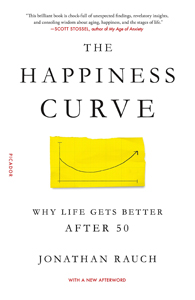 Jonathan Rauch, The Happiness Curve; Why Life Gets Better After 50 (New York: St. Martin's Press, 2018), 244pp.
Jonathan Rauch, The Happiness Curve; Why Life Gets Better After 50 (New York: St. Martin's Press, 2018), 244pp.
I almost didn't read this book because of its hokey-sounding title, but I'm glad that I did. This is one of those books that deconstructs a powerful cultural myth, in this case the idea that young people are the happiest, and that the older you get, the more unhappy you become. The stereotypes of this image in popular culture (and marketing) are legion. But based upon the growing science of "happiness research," his own questionnaire to 300 people, and dozens of personal anecdotes (including many from his own life), Jonathan Rauch documents that the exact opposite is actually true: "getting older makes us happier."
This is the counter-intuitive, U-shaped "happiness curve." For the first few decades of adulthood, life satisfaction for most people falls, with its nadir around the age of 40 to 50. This is a perfectly normal mid-life malaise, says Rauch, similar to the predictable turbulence of adolescence. Then, also just as predictably, beginning at about age 50, life satisfaction increases by age, almost until the very end. This is true when you factor in all sorts of variables (gender, age, ethnicity, income, country, etc.), and despite the inevitable physical and cognitive declines of old age. In fact, social scientists can now document that "age, all by itself, plays a role as a determinant of happiness."
Rauch is careful to ad that every story is different. What he describes is a "tendency" and not an "inevitability." He repeats the mantra several times that "your mileage may vary." Nonetheless, the research is clear, that after midlife, most people experience a "slow motion emotional reboot." There's a movement away from competition, achievement, and acquisition, and a turn toward gratitude, compassion, and connection: "Living in the present. Taking each day as it comes. Savoring the positive. Dwelling less on the negative. Accepting. Not overreacting. Setting realistic goals. Prioritizing the really important people and relationships in life." In short, there is more sugar at the bottom of the cup.
For more on this topic, see my reviews of the movie Happy (2011), and the books by Karl Pillemer, 30 Lessons for Living; Tried and True Advice from the Wisest Americans (2011), and Tal Ben-Shahar, Shortcuts to Happiness: Life-Changing Lessons from my Barber (2018).
Dan Clendenin: dan@journeywithjesus.net


